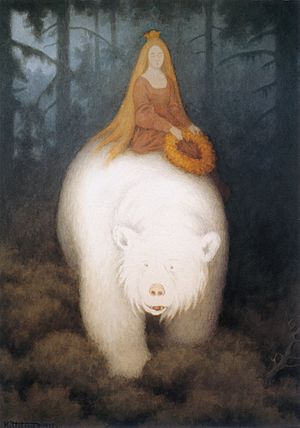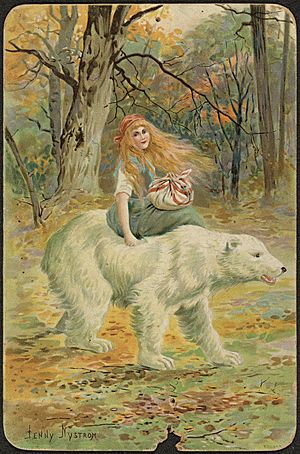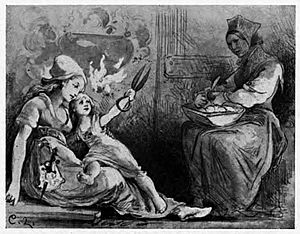White-Bear-King-Valemon facts for kids

White-Bear-King-Valemon (which means Kvitebjørn kong Valemon in Norwegian) is a classic Norwegian fairy tale. It was first shared in a famous collection called Norske Folke-Eventyr. Ny Samling in 1871 by Asbjørnsen and Moe. This story is a type of tale known as Aarne-Thompson-Uther Index 425A, which is all about a hero searching for a lost husband. Another well-known Norwegian tale like this is East of the Sun and West of the Moon.
The Story of White-Bear-King-Valemon
Once upon a time, there was a king with three daughters. Two were not very nice, but the youngest was kind and beautiful. She dreamed of a special golden wreath. When she saw a white bear in the woods wearing that exact wreath, she wanted it. The bear said she could have it, but only if she agreed to go live with him. She agreed, and after three days, the bear came for her. The king tried to stop the bear, but it was too strong.

First, the king sent his oldest daughter, but she wasn't happy riding on the bear's back. So, the bear brought her back. The next week, the second daughter tried and also failed. Finally, the youngest daughter went with the bear. She found it comfortable and exciting. The bear took her to his castle. Every night, in the dark, the bear would turn into a man and visit her.
Each year, the princess had a baby, but the bear would always take the baby away right after it was born. After three years, the princess wanted to visit her parents. Her mother gave her a secret candle. She told her daughter to light it at night to see who her husband really was. That night, the princess lit the candle. She saw a handsome man, but a drop of hot wax fell on his forehead, waking him up.
He was very sad. He told her that if she had waited just one more month, he would have been free from a spell cast by an evil witch queen. Now, because she saw him, he had to go to the witch's kingdom and marry her. He rushed away, and the princess tried to hold onto his fur. She rode with him for a while, getting hurt by branches, until she was too tired and fell off.

The princess began a long search. She found a small house where an old woman and a little girl lived. The old woman said the bear had passed by. The little girl gave the princess a magical pair of scissors that could make silk and velvet appear when she cut the air. The princess continued her journey.
She found another hut, where a different old woman and little girl lived. This time, the little girl gave her a magical flask that could pour out anything she wished for and never ran out. At a third hut, another little girl gave her a special cloth that could make food appear.
On the fourth night, the princess found a hut with an old woman and many hungry, cold children. The princess used her magical items to feed and clothe them. To thank her, the old woman's husband, who was a smith, made the princess strong iron claws. These claws would help her climb the steep mountains to the witch's country.
The princess finally reached the witch's castle. She started to use her magical scissors to create beautiful cloth. The witch wanted to buy the cloth. The princess said she would only trade it for a night with her sweetheart. The witch agreed but gave the prince a sleeping potion so he wouldn't wake up.
The next day, the princess used her magical flask to bribe her way in again. The witch again put the prince to sleep. But a worker nearby heard the princess crying and told the prince what was happening. On the third day, the princess used her magical cloth to get in. This time, the prince did not drink the sleeping potion, and they were able to talk. They made a plan to defeat the witch.
The day came for the prince to marry the witch. Many witches from different lands came for the wedding. But the prince had secretly arranged for carpenters to build a hidden trapdoor on a bridge over a deep chasm. As the wedding group rode across, the witch-bride and all her bridesmaids fell through the trapdoor and were gone forever. With the evil witch and her spell broken, the prince and princess took the treasures from the witch's castle. On their way back to the prince's homeland for their real wedding, they picked up the three little girls. The princess learned that these girls were her own daughters, whom the prince had taken to help her on her difficult journey.
Other Versions of the Story
Many countries have similar fairy tales. For example, in Denmark, there are versions called Prinds Hvidbjørn and Prins Hvidbjørn. Another Norwegian version is called Kong Hvidevallbjørn. These stories often share the idea of a prince who is under a spell and needs a brave princess to break it.
White-Bear-King-Valemon in Pop Culture
- The movie The Polar Bear King is based on this fairy tale.
- Parts of this story can be seen in episodes of the TV show The StoryTeller, like "Hans My Hedgehog" and "The True Bride".
- Valemon is a character in the comic book series Cinderella: From Fabletown with Love.
- The book Sun and Moon, Ice and Snow by Jessica Day George mentions King Valemon.
- A picture from the story became the logo for a publisher called Norsk Folkeminnelag.

